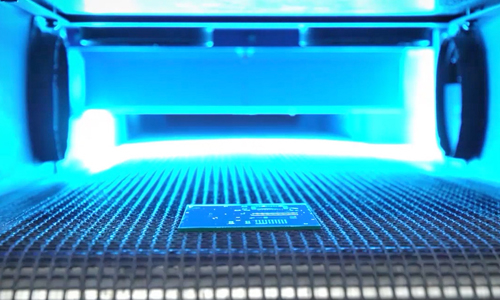Mitigate Oxygen Inhibition in UV Adhesives
Q: In the past, we have seen some light-curable adhesives impacted by a form of inhibition, leaving a residue on the surface. What causes this phenomenon, and how can we avoid it?
This phenomenon is known as oxygen inhibition, and mitigating it is dependent upon several factors:
- Intensity generated over the UV spectrum (280-390 nm)
- Exposure Time
- The heat generated by the UV curing system
- The specific formulation of the adhesive
Light-curable adhesives cure when their photoinitiators are exposed to different wavelengths of light, which break apart the photoinitiators into radical species. These radical species then react with the adhesive oligomers to create long chains and crosslinks. (When you shine a light on the adhesive, it becomes solid).
Usually, by picking a high-intensity light of >1 W/cm2 / 1,000 mW/cm2 and across a broad spectrum range from 280-450 nm to cure UV adhesives, there is so much energy that the adhesives crosslink extremely fast, leaving a firm surface free from tackiness.
Some monomers and oligomers, which are the building blocks of light-curable adhesives, may be susceptible to oxygen inhibition during curing. The phenomenon occurs during the curing step, and if oxygen is present, it can penetrate the surface and interfere with the radical polymerization leaving behind partially reacted monomers and oligomers. The result is the sticky feeling that some people get as they rub a finger across an adhesive's surface or the traces of wet residue they get on their gloved hand.
To mitigate oxygen inhibition, curing a light-curable adhesive to a "slick and dry finish" or a surface free from tack depends on the material's formulation and the intensity and wavelength of the light used. It's been demonstrated that the higher the intensity of the UV light, the better the surface finish.
Typically, short and medium wavelength (280-320 nm) UV light generated by mercury vapor lamps achieve more efficient surface cures but have depth-of-cure issues. Longer wavelength (400-500 nm) systems usually emit a small fraction of UV light in the lower wavelengths and have better depth of cure. The UV/Visible light spectrum in the 320-450 nm range seems to have the best blend of surface and depth of cure.
By altering the curing process with greater light intensity, longer cure time, or slightly adjusting the light wavelength, surface tack can be eliminated. Some UV Adhesives will never cure tack-free, even with these alterations, since they are made for applications without air exposure, such as bonding applications between two substrates.
*The time to cure a light-curable adhesive to a tack-free state should not be confused with the time to reach a complete cure. It only indicates the material's ability to overcome oxygen inhibition at its surface after exposure to a given light intensity level for a specific time.
As a result, users need to consider the intensity of the curing lamps they will utilize.
Higher-intensity lamps can generate massive amounts of intensities measured in W/cm2. For example, some spot-lamp systems emit up to 15-20 Watts/cm2 (measured at 365 nm). It is relatively easy to cure most adhesives to a tack-free state with a high-intensity light-curing system that emits both UV and visible light.
We have observed that most adhesives have a minimum intensity threshold where they will go tack-free within a specific time and a minimum total energy threshold to get a complete cure.
Look at the equation "Watt/cm2 x seconds = Joules/cm2". You can vary the intensity in Watts against the time of exposure in seconds to get the same amount of Joules/cm2:
2 Joules/cm2 = 2 Watts/cm2 x 1 second or 2 Joules/cm2 = 0.02 Watts/cm2 x 100 seconds.
You get the same total energy in both situations (high intensity for a short time or low intensity for a long time), but you may fall below the minimum intensity threshold at 0.1 Watts/cm2 – so you will never get a surface free from tackiness.
Sometimes people find it beneficial to fix the problem of oxygen inhibition differently and flood the curing area with nitrogen or argon (inert) gas during the cure. The inert gas displaces the oxygen on the surface, providing a tack-free finish even with low-intensity light sources.
Mitigating oxygen inhibition in light-curable materials is possible by choosing the proper adhesive, process, light wavelength, exposure time, and lamp intensity.

